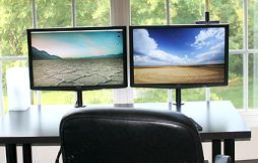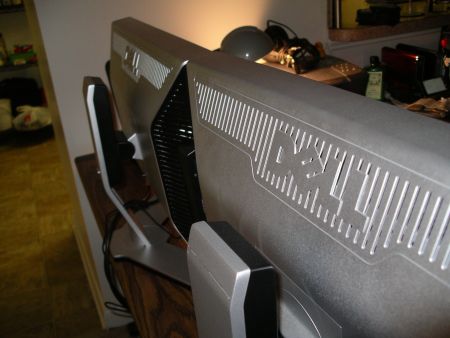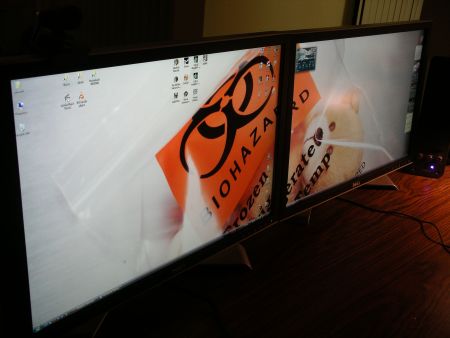Tips For The Multi-Display Life
Thinking about adding a second monitor to your desk? Here are reasons to take the plunge, and options to consider while shopping and setting it up.

A Tale Of Two Monitors

At homes and in offices, we’ve started to notice more than one display per desk. Ask the users of these multi-monitor desks whether they’d be willing to return to a single monitor system, and they’ll likely tell you they’ll give up the second display when you pry it from their cold, dead hands. So, what’s the appeal? Do multiple displays really make computer users more productive? If so, are three monitors better than two? Is there such a thing as too many displays, or too big of a display? Those are the questions we aim to answer in this article. Whether you already have a second monitor or you’re considering picking one up to add to your workspace, there are a couple of things you should consider to get the most out of your multi-display setup. First, make sure to pick the right size and the right type of monitor for the work that you do. Second--make sure to use the right software to get the full benefit of having multiple displays connected to your computer. We’ll help you determine both.

Why are size, type, and software so important? For example, if you’re a PC gamer, you should have different priorities when buying a second monitor than a software developer or a Web designer. Similarly, a movie buff looking for a big display to replace the TV will be looking for something different than a PC gamer. Alternatively, if you’re a laptop or netbook user, you may want a different kind of display than a desktop user, who might be looking to match the experience he gets on each monitor.
Over the course of this tutorial, we’ll dive into those scenarios, and other considerations, such as making sure to take your workspace into account when shopping for a display. Also, we’ll look at some popular multi-monitor configurations and displays, as well as some software options that will help you get the most out of your multi-monitor workstation.
Get instant access to breaking news, the hottest reviews, great deals and helpful tips.
Current page: Tips For The Multi-Display Life
Next Page Multiple Displays and Productivity-
cadder I run CAD and have 2 22" 16:10 displays on my desk. This is almost too much width, it sacrifices open space on each side that I would use to lay large documents for reference.Reply
If you already have one monitor and you want to buy a second one, first measure your space, second measure the height and width of your current monitor. It might look funny if you have a 4:3 monitor that is fairly tall and you buy a widescreen that ends up being wider but not quite as tall. But I think it would be OK if the new widescreen is taller. Also be prepared to have different colors between the 2 monitors. One might look a bit blue compared to the other one for instance, and it might be difficult to match the brightnesses between them. If possible buy 2 matching monitors and replace what you already have.
Of course always check that your computer has ports for connection of 2 monitors. Older PC's will have 15-pin VGA connectors, newer PC's will probably have the rectangular DVI connectors, or even HDMI. Monitors will come with different types of inputs, and possibly with a variety of cables and/or adapters. If you know what you have then when you buy your monitors you can be sure they will work right away without needing another trip to the store for new cables and/or adapters. -
socalboomer Dual monitors is also very inexpensive - dual 17" monitors can greatly increase your real estate and your productivity for very little money (17" monitors are CHEAP).Reply
Personally, I use four, stacked 2x2, and it is amazing. One is dedicated to email, one to other email plus calendars and utilities, one is for terminal windows (to servers) as well as general work, and a wider monitor is there for general purpose. Amazing - and go back to even dual monitors is really limiting!
One little note - for more than two monitors, you're going to need a second video card (or a single ATI) - make sure your computer will handle it (likely need dual PCIx16 slots, at least physical slots) - but oh it's worth it! -
liquid0h My office at work uses dual screens. I remember when we first got them, we thought it might have been a waste of money. But going on 3 years now and we haven't looked back. Working with multiple Excel sheets or Access tables is a breeze now.Reply -
m-manla I'm planning to replace my old 22" 16:10 monitor in for two 22" 16:9 monitor. I have worked on dual screens in different occasions and there is nothing like it.Reply -
tommysch As a gamer I run a 24" 1920*1080 main screen and a 19" 1280*1080 secondary screen. Its particularly useful when playing a FPS competitively. You can have your GPU temp, CPU temp, ping to many references, bandwidth monitor, vent/mumble/TS always in sight, core usage, RAM usage and messenger while playing a full screen game. I dont even use my G15 screen anymore.Reply -
skpman thanks TH! i was really looking for the software that gives you dual taskbars... just bought Ultramon! loving itttReply
BTW my work sucks. us engineers are using 17" (yeah, seriously) monitors. I bought my own secondary because it was getting so frustrating. My 26" at home is more than enough for my personal needs...
On a related note.. anyone from TH know about this product:
http://www.soundgraph.com/fingervu706-feature-en/
-
ds1495 Oops, just noticed a minor little spelling error in the article. When it says: "If so, are three monitors better than too that should be spelled two :PReply
Anyways, nice article, I have been looking into getting a second monitor for a while now, perhaps I'll take the plunge now. -
JohnnyLucky Thank you for a very informative article . Ever since I built my new pc 3 months ago I've been wanting to get mutiple monitors for both work and play. The article cleared up some questions I had about monitor and desk sizes. Turns out I was right in thinking my 23 inch deep desk would be too shallow for what I want.Reply -
volks1470 hooray for me, I just took the plunge a week ago. ATI makes a multi-monitor setup such a breeze. I love bezel compensation!Reply
